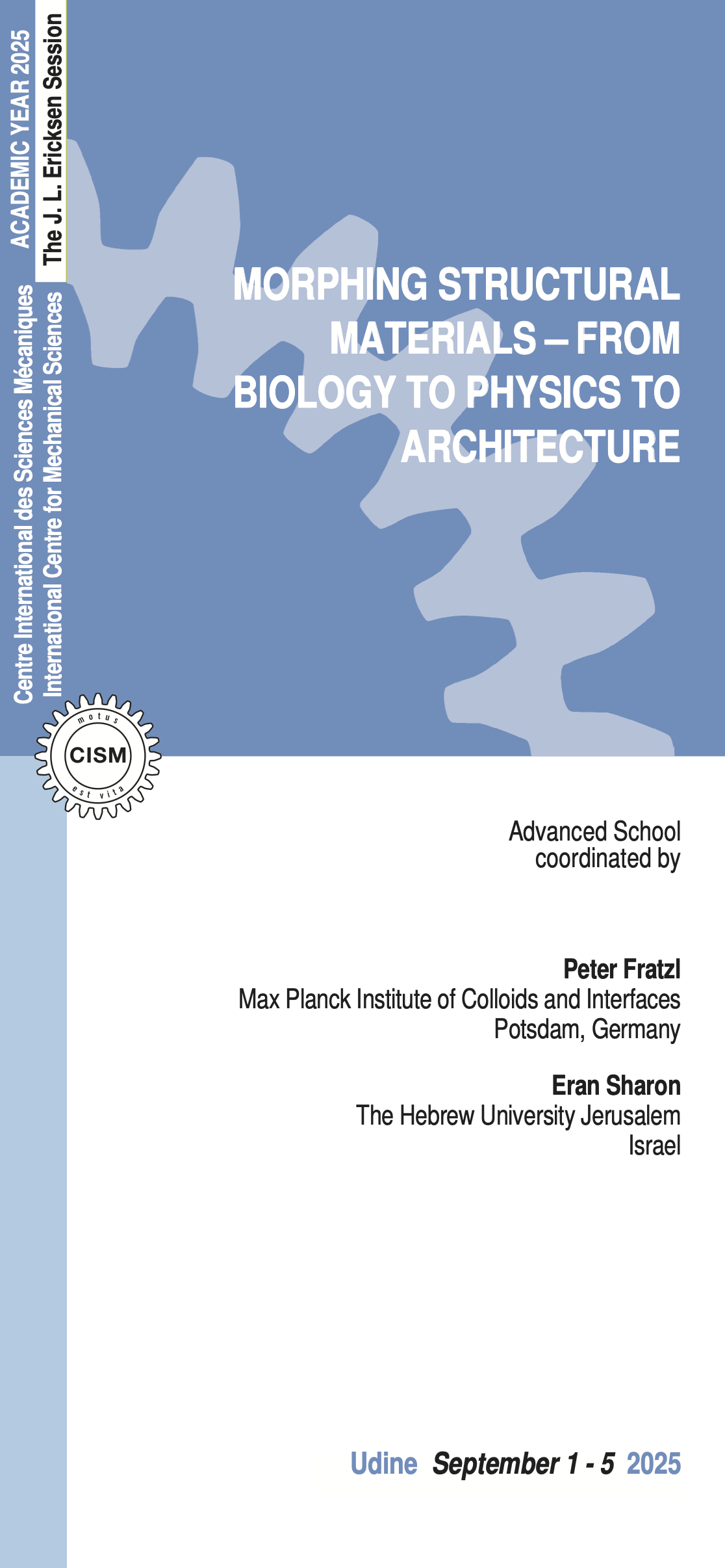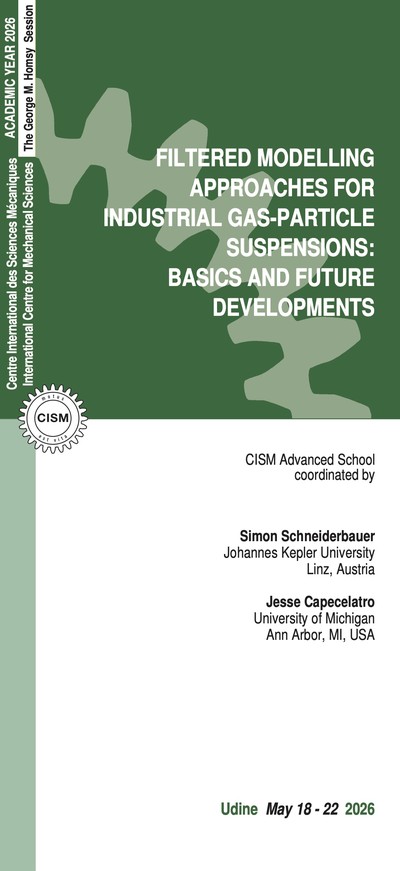Matter is rarely completely static: often matter can morph. This is true for all living systems that grow, adapt and change shape. Indeed, cells divide, leaves and fungi grow, octopuses transform, and wings reshape to control flight. But it is also true that bread rises and that pasta swells. While morphing is omnipresent in the living, it is not confined to it. Harnessing morphing capacities has many potential applications, from machines and robots to architecture.
The goal of this course is to review the current and fast-growing knowledge about structural materials that change shape or develop spontaneous internal stresses that improve their properties. The emphasis will be on potential applications in the built environment, from houses to infrastructures.
Lecturers from physics, engineering, biomaterials science and architecture will cover this topic in an interdisciplinary way.
The mechanics of shape-change requires the physical understanding of how internal stresses in conjunction with the overall shape lead to macroscopic deformation. This raises a number of questions that will be addressed: To what extent can one predict the final shape? In which cases and in which way is it possible to solve the reverse problem? Which ways of inducing shape change, such as air inflation, water-based swelling and shrinking, thermal expansion, have been addressed theoretically and practically? How can shape-change be used for self-assembly and dis-assembly of morphing units? What is different at large scales that are relevant for architecture and where gravitational forces play a major role?
Nature is a major inspiration for shape-change due to its ability to grow and remodel. But natural systems, plants in particular, evolved to use “passive” morphing that does not involve an active metabolism. Major examples are seed dispersal systems, such as the pine cone and many others. The course will also address natural examples and review the current knowledge in the field in order to provide a basis for the inspiration of technical structural materials that are able to morph.
Examples from architecture will be discussed, including inflatables, assemblies of morphing and non- morphing particles, and composites with internal stresses. But architecture is not only an engineering field but also requires design knowledge and approaches. One of the goals of this course is also to initiate the participants to research and development approaches that combine scientific and engineering methods with techniques from design.
In nature, morphing has always been critical– it is about growth and survival; a matter of life itself. Along with scientific observations, insights and theorems on natural morphing matter, shape-shifting permeated the dreams and fantasies of mythology, folklore, fiction and the human imagination.
The vision that led to the development of this course is that morphing will also increasingly impact our built environment, perhaps encompassing more sustainable solutions than what is common practice today.
Eder, M., et al.: 2021. "Wood and the activity of dead tissue." Advanced Materials 33 (28). doi: https://doi.org/10.1002/adma.202001412.
Fratzl, P. et al.: 2009. "Biomaterial systems for mechanosensing and actuation." Nature 462 (7272). doi: https://doi.org/10.1038/nature08603.
Armon, S. et al.: 2011. "Geometry and mechanics in the opening of chiral seed pods." Science 333 (6050):1726-1730. doi: 10.1126/science.1203874.
Blonder, A. et al.: 2021. "Shaping by internal material frustration: shifting to architectural scale." Advanced Science 8 (24):2102171. doi: 10.1002/advs.202102171.
Jourdan, D. et al.: 2023. "Shrink & Morph: 3D-Printed Self-Shaping Shells Actuated by a Shape Memory Effect." ACM Trans. Graph. 42 (6):Article 187. doi: 10.1145/3618386.
Tricard, T. et al.: 2020. "Freely orientable microstructures for designing deformable 3D prints." ACM Trans. Graph. 39 (6):Article 211. doi: 10.1145/3414685.3417790.
Dierichs, K. et al.: 2021. "Designing architectural materials: from granular form to functional granular material." Bioinspiration & Biomimetics 16 (6):065010. doi: 10.1088/1748-3190/ac2987.
Koleva, D. et al.: 2022. "Dsigning Matter: autonomously shape-changing granular materials in architecture." In ACADIA 2021 -Realignments: Toward Critical Computation: Proceedings of the 41th Annual Conference of the Association of Computer Aided Design in Architecture (ACADIA), edited by B. Bogosian et al.:, 280–291.
Gao, T. et al.: 2023. "Pneumatic cells toward absolute Gaussian morphing." Science 381 (6660):862-867. doi: 10.1126/science.adi2997.
Siéfert, E. et al.: 2019. "Bio-inspired pneumatic shape-morphing elastomers." Nature Materials 18 (1):24-28. doi: 10.1038/s41563-018-0219-x.
Aharoni, H. et al.: 2018. "Universal inverse design of surfaces with thin nematic elastomer sheets." Proceedings of the National Academy of Sciences 115 (28):7206-7211. doi: 10.1073/pnas.1804702115.Liu, M. et al.: 2023. "Shape morphing directed by spatially encoded, dually responsive liquid crystalline elastomer micro-actuators." Advanced Materials 35 (5):2208613. doi: https://doi.org/10.1002/adma.202208613.
5 lectures on (of which one Design session):
Experimental material research, materials design, alternative shaping processes, frustrated matter on a architectural scale, frustrated fibre-composites.
5 lectures on (of which one Design session):
Materials design, designed granular materials, design vision, design exploration, parametric design model, integrating materials science and design models.
5 lectures on (of which one Design session):
Force generation in biological systems, molecular motors, osmotic pressure, biological shape-change materials, growth, remodeling, swelling-shrinking, bioinspired fiber-based designs for shape-change.
5 lectures on (of which one Design session):
Geometry processing for computational fabrication, 3D modeling of internal structures for additive manufacturing, geometry and trajectory optimization.
5 ectures on (of which one Design session):
Physics and mechanics of plates. Geometry of surfaces. A review of “active” materials and their use for the design of shape-changing plates.
1 introductory lecture together with Antonio De Simone, CISM Secretary General
5 lectures on (of which one Design session):
Active soft matter and its composites, geometry, topology and mechanics of shape changing materials in different forms (films, particles, filaments, core-shell structures, knots, and 3D-printed cellular and shelular structures).
ADMISSION AND ACCOMMODATION
The course is offered in a hybrid format, allowing participants the flexibility to attend either in person or remotely via the Microsoft Teams platform.
Admission to on-site attendance is granted on a first-come, first-served basis to comply with the capacity of the lecture room.
Application forms should be submitted online through the website: http://www.cism.it. A confirmation message will be sent to participants whose applications are accepted.
Registration fees:
- Early Bird On-Site Participation: € 650.00 + VAT* - Deadline: July 1, 2025
- Late On-Site Participation: € 800.00 + VAT* - Deadline: August 19, 2025
- Live Streaming Online Participation: € 250.00 + VAT* - Deadline: August 19, 2025
On-site participation includes a complimentary bag, five fixed menu buffet lunches, hot beverages, downloadable lecture notes.
Online participation includes downloadable lecture notes.
Upon request, and subject to availability, a limited number of on-site participants can be accommodated at the CISM Guest House for € 35 per person per night. To request accommodation, please contact foresteria@cism.it.
CANCELLATION POLICY
Applicants may cancel their registration and receive a full refund by notifying the CISM Secretariat in writing (via email) no later than:
- July 1, 2025, for early bird on-site participation;
- August 1, 2025, for late on-site participation;
- August 19, 2025, for online participation.
No refunds after the deadlines. Cancellation requests received before these deadlines and incorrect payments will be subject to a € 50.00 handling fee.
GRANTS
A limited number of participants from universities and research centers who do not receive support from their institutions can request a waiver of the registration fee and/or free lodging.
Requests should be sent to the CISM Secretariat by July 1, 2025, along with the applicant's curriculum vitae and a letter of recommendation from the head of the department or a supervisor confirming that the institute cannot provide funding. Preference will be given to applicants from countries that sponsor CISM.





